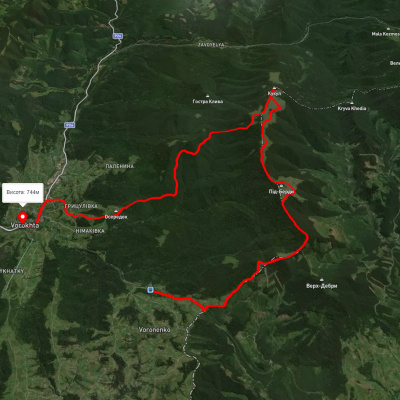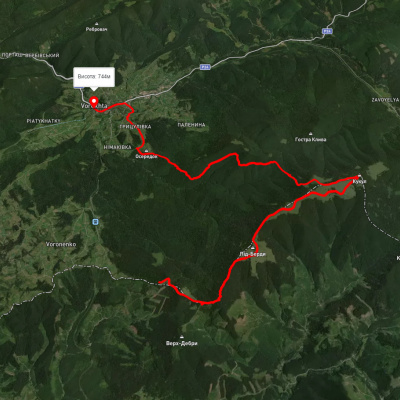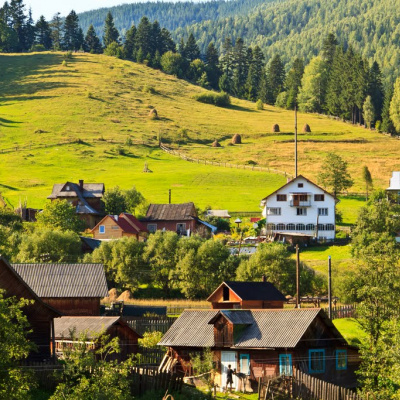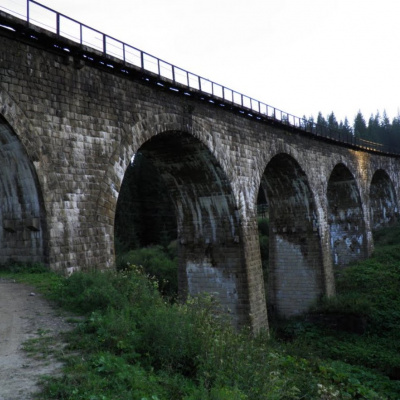Vorokhta
Vorokhta is an urban-type settlement of the Yaremche City Council in Ivano-Frankivsk Oblast. It is located at an altitude of 850 meters above sea level, on the Prut River. The Vorokhta resort is a training center for Ukrainian athletes in ski jumping, biathlon, and cross-country skiing. According to legend, the name of the village dates back to the seventeenth century. According to legend, the first inhabitants of Mocherniaky had a servant, a deserter from the army, whose name was Vorokhta. He was very capable, and people often asked him for advice, saying, "I'm going to Vorokhta." Hence, the name of the new mountain settlement, Vorokhta, was given to the people.
It was founded in 1568 by Vasyl Yaniuk, who left his native village of Kosmach with his cattle. It became known in the 1960s when, after the demolition of a large Hutsul house, a one-liter tetrahedral old bottle with the following inscription was unearthed in the center of the village: Lwów, Lemberg, Maison Fodee 1782 J.A. Bachewski. During these works, M. Mocherniak, a widow, the wife of V. Mocherniak, the son of Ivan from Mocherniak's second wife I. She picked up the bottle and, having made sure that there was no treasure in it except for half-decayed documents (the Mocherniaks served in Dovbush's vigilante and the bottle could have contained some of Dovbush's gold), handed the documents to M. Sankovych. The paper was crumbling-everything had to be folded secretly because Mocherniak and Sankovych could be implicated in espionage. Those documents described the history of Vorokhta in detail (apparently, Mocherniak I. compiled it all on the basis of even older records). Separately, there was a card with a part of the text (everything else was impossible to make out, the inscription there was literally as follows: Taki są odpowiednie doswiadczenia że z poczatku na pierzem pagozke przybył Wasyl Yanik z Kosmacza w 1568 r. Michał Worochta przybyl w 1598. A. Pob. M. Pabusiewicz 1/11 1610.
These documents shed some light on the history of Vorokhta, but unfortunately, they were not preserved. Prior to that incident, there was a version about the foundation of Vorokhta in 1780 (this date is indicated on the information board), and of course in the 1690s, but these versions were not confirmed. In 1998, rumors started circulating about the 400th anniversary of Vorokhta. This information reached the Yaremche City Council. However, there were no relevant documents to confirm the authenticity of these rumors.
Vasyl Yaniuk from Kosmach came to this area in 1568. When he reached a vast field, he settled there. This place is called Yanivskyi Dil. When the cattle grazed the pasture, Yaniuk went in search of others. He walked through the forest to the west and came to the windbreaks of centuries-old fir trees. Here he stopped, tied his horse, went up the slope and saw a beautiful long-striped field behind the windbreak. Yaniuk hesitated: it was hard to get to the field, but it must be very rich in pasture. He returned to his work. He told the shepherds everything, and they went to that field. It took us a whole week to get there. There was a good landscape, a lot of pasha, but we returned to Kosmach for the winter. In the spring, they returned to the new field and named it Rizha (today the Rizha meadow). One day Yaniuk saddled his horse and went to the foot of the mountain (Rizhia was near the top); there spruce forests turned into beech gaps. Yaniuk went west again and saw large fields. He returned to Rizhia and told everyone about it. In a week, all the cattle and animals were in those fields, a barn was built for the cattle and a small living room was separated by a wall. But for the winter Yaniuk returned to Kosmach. In the spring, he moved the entire household to a new field. Here he began to live with the household. In the third spring after Yaniuk's arrival, he began to build his house on the plains above the cliff. It was 1568.
In 1598, a Polish deserter, Mykhailo Vorokhta, who did not want to return to Zakarpattia and was also a talented weaver, settled with the Dederchuks on Yanivskyi Hrun (where there were large fields). Vorokhta's fame quickly spread to all the areas under Yaniuk's control. Vorokhta did not have a house of his own, but he met Yaniuk and took his daughter Maria as an assistant, making a loom for her. In this way, Mykhailo expanded his production. Then he married Maria in Berezov. In 1598 (after the wedding) this place was nicknamed Vorokhta. Yaniuk, mentioned above, had three daughters: Yevdokiya, Maria, and Anna. He married Maria to Vorokhta, Yevdokiya to Dederchuk, and Anna to Voroniuk (the founder of Voronenka).
From the end of the nineteenth century, Vorokhta developed as a sports and tourist center. This was facilitated by the construction of a railroad through Vorokhta in the summer of 1894. In 1895, a stone arch bridge was built. With a total length of 130 meters, the span is 65 meters. The bridge is included in the list of the longest stone bridges in Europe and the world (now the bridge is not in use).
Vorokhta was a village (hamlet) of Mykulychyn until October 1, 1927, when it received the status of a village in the Nadvirna district of the Stanisławów province.
In the 1930s, several boarding houses for wealthy tourists were built here, and in 1957 a ski school was opened. Today, Vorokhta is one of the main centers of tourism in Ivano-Frankivsk region, both in summer and winter. There are several ski lifts for skiing enthusiasts. Near the Avangard base, there is a 300-meter rope tow and a 2-kilometer chair lift. There is a 250-meter rope tow on the Makivka River. Two more 100-meter lifts are being installed during the winter season. Not far from the village is the Zaroslyak sports and tourist center, where the route to the highest peak of Ukraine, Hoverla, begins.
Vorokhta is located in the Carpathian Mountains, at a high altitude above sea level. It is surrounded by mountains and forests on almost all sides.
The small village is home to friendly people. Vorokhta is surrounded by beautiful scenery. There are ski lifts. There is a training base for Ukrainian ski jumpers: two ski jumps are covered with artificial grass. That's why people jump on them all year round. Not far from the village is the Zaroslyak sports and tourist center, where the route to the highest peak of Ukraine, Hoverla, begins.
Transport connection
- Daily passenger train "Hutsulshchyna" runs from Kyiv to Rakhiv via Vinnytsia, Ternopil, Kolomyia. There are suites, compartments, and reserved seats. Fare is about one hundred and seventy hryvnias (reserved seat to Kyiv).
- Daily passenger train "Halychyna" runs from Kyiv to Vorokhta via Vinnytsia, Ternopil, Lviv. There are luxury, compartment and reserved seats. Fare is about one hundred and seventy hryvnias (reserved seat to Kyiv).
- Daily passenger train Lviv - Rakhiv via Ivano-Frankivsk. There are compartment, second-class, and general cars.
Accordingly, passengers from Lviv and Kyiv can choose the most convenient trip for them.
Suburban trains: Vorokhta - Kolomyia - Vorokhta, Kolomyia - Rakhiv - Kolomyia, Ivano-Frankivsk - Rakhiv - Ivano-Frankivsk, Rakhiv -- Lviv.
Suburban buses to Tatariv, Yaremche, Verkhovyna, etc. There are almost no direct buses to Bukovel and Yablunytsia, you need to change buses in Tatariv to Yaremche-Bukovel, Yaremche-Yablunytsia, etc. The bus routes in the region are served by Sprinter and Etalon minibuses, which are packed to capacity even in the off-season, so if possible, you should use them exclusively to get to the nearest station.
The Petrovychi family team was founded in Vorokhta. The Petros band and the Jarab band were also founded and live in the village. Vorokhta is part of the Carpathian National Nature Park.
Viaducts
During the Austro-Hungarian Empire, in 1894-1895, four railroad arch bridges-viaducts-were built by Italian prisoners of war:
- The viaduct near the Avangard base is 130 meters long and the largest arch (over the Prut River) is 23 meters long.
- The bridge over the Prut River, 500 meters west of the Church of the Nativity of the Blessed Virgin Mary. Its total length is 200 meters, and the length of the main arch is 30 meters. It is the largest bridge in the Yaremche City Council, and one of the largest in Europe at the time.
- Bridge over the Paradzhyn Stream on Vysochena Street. The total length of this bridge is 185 meters.
- The bridge near the entrance to the village of Voronenka, which is 170 meters long.
In order to preserve the two largest bridges (the bridge over the Prut and the bridge over the Parochyn), in 2000 a modern bridge was built near them. Nowadays both bridges are not functioning, the other two are still in operation.
Temples
A monument of Hutsul wooden architecture dating back to 1615 is the Church of the Nativity of the Virgin Mary, which was moved from the village of Yablunytsi in 1780. In 1925, during the construction of a new church, the bell tower, all the jewelry and icons were taken out of the Church of the Nativity and moved to the Church of Peter and Paul[4]. The building had been falling apart since 1931. 64 years after 1931, 15 years after 1979, on Easter 1994, the church was solemnly consecrated after restoration by Bishop-Ordinary of the Kolomyia-Chernivtsi Diocese of the UGCC Pavlo Vasylyk.
Thus, since 1600 Vorokhta could use the Voronenka church, which was far away (8 km), so in 1602 (or 3) a church chapel was built here, at the crossroads near the house of culture. Under what circumstances it was destroyed is unknown. During the Austro-Hungarian Empire, the chapel was restored in a smaller form. But under Soviet rule in 1940, the chapel was destroyed, and the Church of the Nativity of the Virgin Mary was turned into a stable. In 1997 the chapel was restored by V. Panevnyk.
In 1924-1929 (1930), the Church of Peter and Paul was built on a hill near the house of culture. Everything from the Church of the Nativity of the Virgin Mary, including the bell tower and the church museum, was moved to this church. There is a small cemetery nearby. This church is now a parish church.
In 1904-1906, the Church of the Assumption of the Blessed Virgin Mary was built near the railway station, where the priests' residence was located. It was small but very beautiful inside and out. Since 1940, the church has been out of use. In the 2000s, the building was restored and used for its intended purpose.
Які туристичні (пішохідні) маршрути проходять через/біля Vorokhta?
Пропонуємо пройти такі туристичні (пішохідні) маршрути через/біля Vorokhta: с. Вороненко, через г. Кукул до смт. Ворохта, с. Вороненко, через г. Кукул до смт. Ворохта, с. Вороненко, через г. Кукул до смт. Ворохта, смт. Ясіня, через г. Петрос, г. Говерла, г. Кукул до смт. Ворохта, с. Вороненко, через г. Кукул, г. Говерла, г. Піп Іван Чорногірський до с. Ільці, смт. Ясіня, через г. Петрос, г. Говерла до смт. Ворохта







